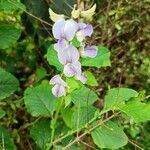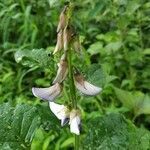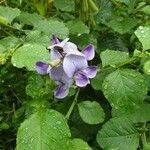Erect much branched annual, up to 1 m. tall.. Stem 4-angled, sulcate, shortly appressed or spreading pubescent.. Leaves simple; blade ovate to elliptic, up to 5·5–12·5 cm. long, 4·5–8 cm. wide, thinly appressed or spreading pubescent on both surfaces; petiole ± 4–9 mm. long.. Stipules foliaceous, ovate-falcate, acuminate, up to 7–21 mm. long, 5–13 mm. wide.. Racemes up to 11–24 cm. long, with up to 24 laxly to rather closely arranged flowers; bracts caudate, expanded at the base, ± 1–5 mm. long; bracteoles inserted on the lower part of the pedicel, filiform, ± 0·5–2 mm. long.. Calyx 4–5-lobed, 7–11 mm. long, with the tube protracted on the lower side, thinly appressed pubescent; upper lobes acuminately triangular, ± twice as long as the tube.. Standard elliptic to obovate-elliptic, pale yellow, tinged blue, glabrous outside; wings obovate-elliptic, longer than the keel, blue or purple; keel rounded about the middle, with a fairly short slightly incurved twisted beak, 8–12 mm. long.. Pod shortly stipitate, oblong-clavate, ± 37–50 mm. long, 10–12 mm. across, thinly appressed or spreading pilose, ± 16-seeded.. Seeds oblique-cordiform, with the narrow end strongly incurved, practically smooth to distinctly papillose, shiny, brown.
Herbs, erect, 50-100 cm tall. Branches 4-angled, glabrescent. Stipules leaflike, ovate-falcate, 5-8 mm. Leaves simple; petiole 3-5 mm; leaf blade ovate to elliptic, 10-15 × 3-5 cm, thinly membranous, abaxially densely pubescent, adaxially glabrous, base broadly cuneate, apex acuminate. Racemes terminal, 10-20-flowered; bracts linear, ca. 1 mm. Pedicel 3-4 mm; bracteoles inserted apically from middle of pedicel. Calyx subcampanulate, 8-10 mm, 5-lobed; lobes lanceolate, slightly longer than tube. Corolla pale yellow, white, or often tinged blue; standard orbicular to obovate, 1-1.8 cm, base with 2 appendages; wings oblong, 1-1.6 cm; keel ± as long as wings, exserted beyond calyx, rounded with an incurved, fairly shortly twisted beak. Ovary subsessile, pilose on apical part. Legume oblong, 2-4 cm, 10-12-seeded, pubescent. Seeds nearly smooth to papillose, shiny. Fl. Aug-Oct, fr. Nov-Dec.
Flowers pale yellow tinged blue, in leaf-opposed and terminal racemes.
Erect shrub, 2–3 ft. high, with angular branches



